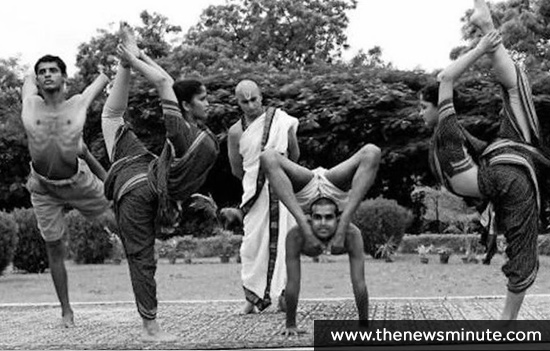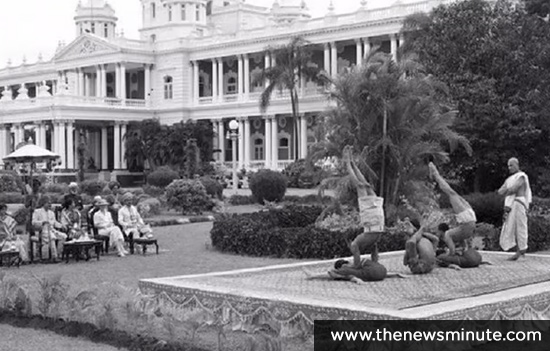- In Mysore king Krishnaraja Wadiyar III (1794-1867)
wrote a scholarly book on Yoga Sritatvanidh.
In 1933, Krishna Raja Wadiyar IV set up the Palace Yogashala with T Krishnamacharya
as its head. He and students like B. K. S. Iyengar & Indra Devi popularised
Yoga in India and the West.
From time immemorial, yoga and India
have been synonymous. This holistic method of health care has a long tradition
that spans over many centuries. However, it remained a little known factor that
the credit of reviving and popularising this ancient art in modern times goes
to the city of Mysuru, the then capital city of the princely state named after
the city.
In fact, revival of the tradition of yogasana with the royal patronage of the Wadiyar dynasty was one of the epochs of India’s modern history. As such, the state of
Mysore was well-known for preserving and conserving the Indian traditions and
customs, which otherwise were suffering for want of patronage under the
British.
This
article was first published in the Bhavan Journal.
The Yogi Maharaja
Mysore’s tryst with yoga began soon after the fourth Anglo-Mysore war of 1799. This military operation marks the beginning of a new era in the history of South India. In that year, the British defeated Tipu Sultan, the last native ruler to challenge the growing power of the British in the Indian sub-continent. After Tipu’s fall, the kingdom of Mysore was restored to the Wadiyar dynasty.
The scion of the royal family, a five year old child Krishnaraja Wadiyar III
(1794-1867) was placed on the throne.
Interestingly, the Maharaja developed a
passion for yoga at an early age. As he grew up, the Maharaja emerged as an
expert in the art of yoga exercises. Not only had he revived this art but he
also became an expert to the extent of authoring a scholarly work named Sritatvanidhi. This book deals in detail
with various aspects of yoga exercises and explains with diagrams not less than
122 different yoga postures.
Besides, the Maharaja developed a library on a full scale with collection of some of the most valuable works on this art. Unfortunately, the great fire that destroyed the old Mysore palace in 1897 also destroyed important records of yoga teachings going back centuries. But Maharaja’s treatise ‘Sritatvanidhi’ somehow survived.
The Mysore Palace Yogashala
Modern yoga scholar Mark Singleton
credits Nalvadi Krishnaraja
Wadiyar for reviving the Indian exercises including yoga beginning in the later
1900s in the Mysore state. In 1926, the king (Krishna Raja Wadiyar IV) was
on a visit to Varanasi, the most holy places for the Hindus. Here he heard
about the fame of a great yoga master T. Krishnamacharya. The king was quick to
meet him, bring him to Mysore and appoint him as his yoga Guru.

Krishnamacharya (1888 to 1989) was the
native of Muchukundapura in Chitradurga district of Karnataka, which was then a
part of Mysore state. Later, he went to Varanasi for higher studies and
subsequently is said to have learnt yogasanas from
Yogeshwara Ramamohana Brahmachari who was residing at Mount Kailash. By
the time he arrived at Mysore, he was adept in the art of yogasanas as well as
the Vedic scriptures.
In the beginning he was appointed as the
teacher at the Sanskrit school and later was placed in charge of the Yogashala
(Yoga training centre) set up at the palace
premises in 1933. This centre was basically to train the members of the
royal family in this art of physical exercises. Gradually, others were also
allowed by obtaining special permission. In the second year itself, the total
number of boys practising there grew to thirty two.
The Yogashala gave a thrust for popularising the yoga exercise and served as a platform for Krishnamacharya to carry on experiments, which were to give a tangible shape for the now popular methods of practising yogasana. Here Krishnamacharya made several experiments and revived many asanas (yogic postures) consulting ‘Sritatvanidhi’ and other ancient texts.
His experiments went a long way in
reviving many asanas which form the part of yoga syllabus of modern times. The Vinyasa Yoga (practice of asanas in
sequence), one of the most popular methods of yoga practice was his brainchild.
He has also authored a scholarly book titled Yoga Makaranda in Kannada, which later was translated into English with the same title. His other works are ‘Yogasanagalu’, ‘Yoga Rahasya’ and ‘Yogavalli’.
Fame of Yogashala

The Mysore Palace Yogashala has over the
years grown into a premier school of yoga practice. In 1941, Life, the well-known American news magazine carried a photo feature titled ‘This is Real Yoga’ and published 22 photographs of different yoga postures demonstrated by Krishnamacharya’s students in the courtyard of the Jaganmohan Palace. Around this time, this Yogashala gained popularity and caught the attention of many including a good number of eminent Westerners. With Maharaja’s encouragement, Krishnamacharya also travelled across India giving lectures and demonstrations to promote yoga.
Krishnamacharya trained
and produced some of the best yoga teachers of the modern times. In
1938, Indra Devi (Eugenie Peterson), who popularised yoga in the West learnt
yogasanas under Krishnamacharya here. She was one of the earliest yoga teachers
in the United States and died at an advanced age of 102 in the year 2002. She
enjoys the credit of introducing yoga to top political leaders, cinema stars
and other such celebrities in the West.
Krishnamacharya’s other celebrated students were K. Pattabhi Jois, B. K. S. Iyengar, Srivatsa Ramaswamy, A. G. Mohan and his son T. K. V. Desikachar. All of them have played a key role in popularising yoga among the common folk and taking this art beyond its traditional boundaries.
Taking Yoga to the People
Krishnamacharya took up the cause of yogasana when there was great social taboo regarding the practice of asanas. B. K. S. Iyengar in his biography recalls, “In the early days, Yoga was an alien subject to the Indians. It was not respected by the scholars or pundits or anyone else. They were interested only in the philosophical aspect and not in the practical aspect at all. There was a feeling that those who embraced Yoga in the early days, they may be disturbed.” and abroad.
However, with the passage of time,
conditions changed and the practice of yogasana became extremely popular both
in India and abroad. The Mysore Palace Yogashala and its legendary teacher
Krishnamacharya did play a decisive role in bringing about such amazing
changes. Today’s most popular yogasana methods such as ‘Vinayasa Yoga’ and ‘Ashtanga Yoga’ owe their origin to The Mysore Palace Yogashala.
 Mysore Palace 2017.
Mysore Palace 2017.
The Yogashala remained a centre of yoga
practices for many years. However, curtains were drawn on its glory when India
attained independence and subsequently the dynastic rule in Mysore too came to
an end. The loss of the royal patronage severely
hampered its activities and the Yogashala was eventually shut in 1950.
Afterwards, Krishnamacharya moved to
Chennai and continued his yoga teaching there. But within less than two decades
of its existence, the Mysore Palace Yogashala brought about a revolution with
regard to this ancient art of physical exercise. It planted the seeds which
were to grow into a flourishing tree in the near future. Mysuru city too
secured a special spot in the history of yoga and emerged as a major
destination of yoga practices attracting yoga enthusiasts from across the
globe.
This article was first published in the Bhavan’s Journal, October 16, 2024 issue. This article is courtesy and copyright Bhavan’s Journal, Bharatiya Vidya Bhavan, Mumbai-400007. eSamskriti has obtained permission from Bhavan’s Journal to share. Do subscribe to the Bhavan’s Journal – it is very good.
Also
read
1. 7 interesting
facts about T Krishnamacharya, father of Modern Yoga
2. Krishnamacharya’s Legacy